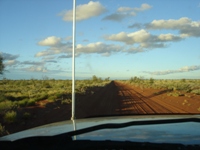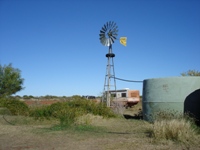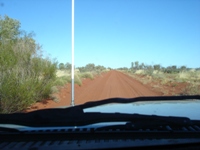
Australia So Much to See


Australian Geographic - The Canning Stock Route
With Aboriginals as guides, 46 year-old surveyor Alfred Canning trekked north in 1906 to establish a route that would eventually bear his name. He was endeavouring to find a way by which East Kimberley cattle could be taken to southern markets. Previous explorers Lawrence Wells and David Carnegie - who had both lost men on their expeditions in the area - advised against continuing the search for such a route. "We have demonstrated the uselessness of any persons wasting their time and money in further investigations of that desolate region," Carnegie wrote.
But at the instigation of the Secretary
for Mines, Canning set out from Wiluna with seven other men, 23 camels, two ponies, 2.5 tonnes of provisions and 1440 L of water.
During the ensuing 14-month survey the team trekked about 4000 km, often relying on the Aboriginal guides to help them find water.
On his return, Canning reported that a stock route could be established with fair feed and good water from 52 wells and watering points. In 1908 he sank the wells. Working in temperatures of around 50°C for weeks at a time his crew completed 51 wells, averaging one every 18 days. The deepest was Well 5, at more than 30 m; the shallowest, Well 42, was just 1.4m.
Many of the wells are now little more than depressions in the ground and some have their water tainted with the corpses of rotting animals. But according to Kevin Atkins, one of the last surviving white drovers to have taken cattle down the Canning, non-functioning wells were fairly common: “Three or four of the wells along the route were out each time.” He quietly describes the three 12–16-week drives he did back in the early 1940s from south of what is now Old Halls Creek to Wiluna, two of them with legendary drover Wally Dowling. "We'd push the cattle along."
The cattle would drag their bums on the steep dunes – they’d stagger up and we’d cover 10–12 miles [16–19 kilometres] a day.” Most of the 31 mobs of cattle that were taken down through the desert up to 1959 were mustered on Billiluna and Sturt Creek stations, out of Halls Creek.
Getting water up from the wells was hard work and the drovers would use a camel to ‘whip’ the water up in a 12 gallon (50 litre) canvas bucket – the often-seen steel buckets at each well weren’t favoured by the stockman.
"You couldn’t hold the cattle back from the wells," Kevin says. "They'd rush to get to the water especially after three or four days. They wouldn't go anywhere though and you’d just have to get the water up and into the troughs."
Once in Wiluna, Kevin would
gather a mob of brumbies from stations such as Carnegie and head back up the stock route, selling them far and wide throughout the
Kimberley. “We’d travel faster with the horses,” he says. “It was an eight-week trip back and we’d bring 40–60 horses back with us.
Horses were in short supply in the Kimberley ’cause of the ‘walkabout disease’ that was prevalent then.” Descendants of those brumbies
still roam the Kimberley today and none are fatter or as well off as the wild horses around Lake Gregory at the northern end of the
CSR.
For forty years, the
Creating the Canning Stock Route - This link, from australia.gov.au, is no longer available
In between lay a vast, harsh landscape of sand dunes, spinifex grass and salt pans.
Surveyed and
created in the early 1900s, the scale of the
Canning Stock Route - the first and last drives
Drover Tom Cole led the first known cattle drive in 1911, and in 1959, drover
Mal Brown led the last. There were only thirty-five known drives, which seems incredible given the huge amount of resources taken
to construct and maintain it.
In 1906, the Western Australian Government appointed surveyor Alfred Canning to survey an overland stock route from Halls Creek in
the
In the 1960s the track began its new phase as the premier route for vehicular adventures. By the early 1980s, more than 100 people were travelling it each year.
It was estimated that more than 500 vehicles made the trip in 2008 and numbers have probably increased since then with the popularity of the track for both Australian and overseas adventure tourists.


Four Wheel Drive Australia request that trailers not be taken on the Canning Stock Route.
Plan to use your swag or tent and leave your camper trailers at home. More than the usual wear and tear caused by travellers towing trailers is of great concern to our fraternity and the locals. Part of the attraction of this route is the challenge of driving through such a vast wild natural area. The track is not maintained and for the few who drive it each year this great experience is being lessened by track and roadside damage caused during attempts to haul trailers over dunes in particular. Nobody wants a highway through this area but it does need suitably set up vehicles to traverse its challenges. With improved durability in camper trailer design, the track is now the weak link rather than the equipment. The damage caused by towing trailers highlights that these are not appropriate for this route.
Time frames:
Most people choose to do the whole
Why do you need a permit? See Why Do You Need a Permit?.
Note: No permits are being issued as the Canning Stock Route remains closed since 2020 due to Covid restrictions, to protect Aboriginal communities, with no time frame given for anticipated reopening. Current May 2022.